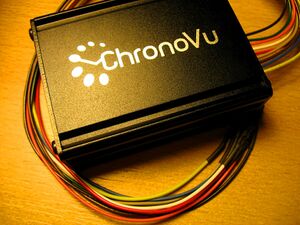ChronoVu LA8
The ChronoVu LA8 is a USB-based 8-channel logic analyzer with up to 100MHz sampling rate. It features a Xilinx CPLD for sampling, 8MB of built-in SDRAM to store the samples, and can trigger on low or high states of any combination of probes. After the 8MB sample buffer is full, the data is transferred to the host using an FTDI USB-to-serial chip.
See ChronoVu LA8/Info for more details (such as lsusb -vvv output) about the device.
Thanks
Many thanks to the vendor (ChronoVu) for freely providing information on the protocol used to communicate with the device. This helped us implement the sigrok hardware driver more quickly. We're happy to see more open-source friendly vendors support sigrok!
Hardware
- Xilinx XC2C256 CoolRunner-II CPLD
- Micron MT48LC4M16A2 SDRAM (8 MByte)
- FTDI FT245RL
- LXH244A (buffer)
- PT70151
Usage
$ sigrok-cli -d chronovu-la8 --samples 8388603 -f binary > samples.dat
The default samplerate is 100MHz (which results in a sampling time of 0.084s). To select another sampling rate use this syntax:
$ sigrok-cli -d chronovu-la8:samplerate=1mhz --samples 8388603 -f binary > samples.dat
Protocol
The ChronoVu LA8 is a USB-based device and presents itself as an FTDI USB-to-Serial device with vendor ID / device ID of 0403:6001 (see also the full lsusb). Talking to the device is thus done using libftdi's ftdi_read() and ftdi_write() functions.
Starting an acquisition
The data acquisition is started by sending 4 specific bytes to the device via ftdi_write(). This configures the sampling and trigger setup and initiates the acquisition.
| Byte | Value | Comment |
|---|---|---|
| 0 | divcount | This byte must contain the divcount value which determines the samplerate/sampletime/sampleperiod (see below). |
| 1 | 0xff | This byte must always be 0xff. |
| 2 | Trigger pattern | This byte contains the trigger pattern (MSB = channel 7, LSB = channel 0). A 1 bit matches a high signal, 0 matches a low signal on a probe. Only low/high triggers (but not e.g. rising/falling) are supported. |
| 3 | Trigger mask | This byte contains the trigger mask (MSB = channel 7, LSB = channel 0). A 1 bit means "must match trigger pattern", 0 means "don't care". |
After these bytes have been sent you need to wait a certain minimal amount of time, then grab the 8MB buffer data from the LA8 using ftdi_read().
Demangling data
However, the data received from the device is not directly usable as it is "mangled" a bit due to internal hardware reasons. So it's required to de-mangle the data first, in order to get it into the final format, i.e., one byte per sample, MSB is the value of channel 7, LSB is the value of channel 0.
Stopping an acquisition
Triggers
Sampling
The device has an 8MB buffer (SDRAM) which is always filled completely with samples. Using the divcount divider value (valid range: 0x00 - 0xfe) samplerates between 100MHz and 392.15kHz can be selected. Depending on the samplerate different total sampling times (from 0.084s up to 21.391s) can be achieved.
The formula for the sample period (not to be confused with the samplerate) is:
sample period = (divcount + 1) * 10ns
The following table shows a small part of the valid divcount values and resulting sample periods, samplerates, and sampling times.
| Divider | Sample period | Samplerate | Sampling time |
|---|---|---|---|
| 0x00 | 10ns | 100MHz | 0.084s |
| 0x01 | 20ns | 50MHz | 0.168s |
| ... | ... | ... | ... |
| 0xfd | 2540ns | ... | ... |
| 0xfe | 2550ns | 392.15kHz | 21.391s |
TODO
- Implement input and output file format support for the ChronoVu LA8 software for interoperability.
- Implement proper trigger support.
- Implement --time and --samples correctly, currently you can only get exactly 8388603 (8MB) samples.
More photos
See also [ this flickr set] for more PCB photos of the device.








